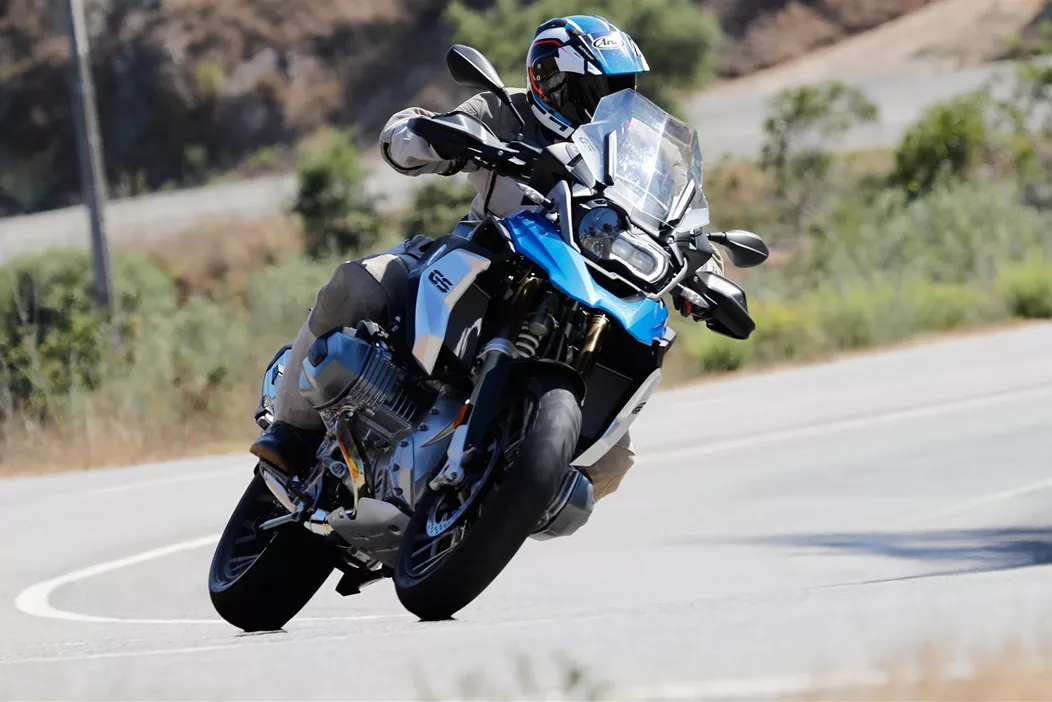Most of the tests at 1000PS revolve around new motorcycles. Not only because they are our main focus, but also because used motorcycles of popular models are hard to come by. Who would want to entrust their beloved, possibly rare gem to the rough hands of journalists? However, there is one place where used motorcycles are present in such numbers that even we get a chance. Cameraman Schaaf and I travel to Filderstadt, south of Stuttgart. In close proximity to the airport, we are welcomed by Limbächer, the largest motorcycle dealer in Europe. Here alone, at the largest of five locations in Germany, around 2,000 bikes of all brands are stacked. In total, about 5,000 bikes are handed over to new owners annually, including very rare models that are hard to find elsewhere. The Harley-Davidson V-Rod VRSCR Street Rod is one such rare specimen, especially because it met with little enthusiasm upon its release and rarely found a loving owner. But why is that? And why is the Street Rod considered by some to be the sportiest Harley-Davidson? We get to the bottom of it.
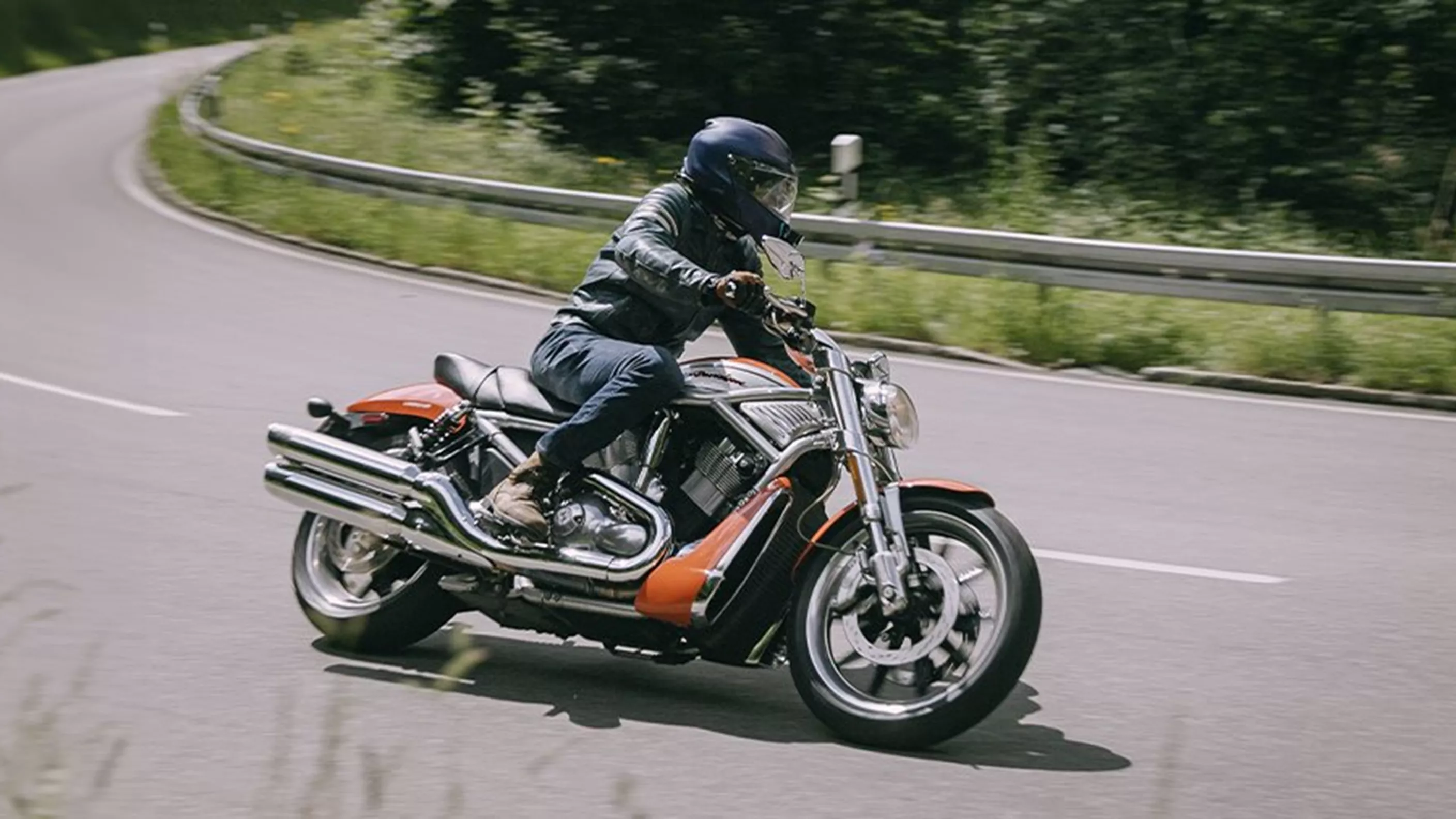
Harley-Davidson V-Rod VRSCR Street Rod Used Bike Review & Test
The most unpopular and perhaps the sportiest Harley of all time
At the beginning of the 2000s, Harley-Davidson teamed up with Porsche Engineering to develop a unique, then-revolutionary model range: The V-Rod Harleys were born. Among them, the V-Rod Street Rod was the least popular but also the most extraordinary of the bunch. We tested whether its poor standing among Harley fans is deserved or if it might find new fame as a used bike.
&width=72&height=72&bgcolor=rgba_39_42_44_0&mode=crop)
Gregor
published on 08/09/2024
In short: The history of the Harley-Davidson V-Rod VRSCR Street Rod
Basically, the collaboration between Harley-Davidson and Porsche Engineering around 2000 is already old news, as it began during the AMF Harley-Davidson era (1969-1981). However, the V-Rod series is undoubtedly the most prominent product of this cooperation. The Harley-Davidson V-Rod models, introduced in 2001, marked a significant departure from the company's traditional design and engine philosophy. Originally conceived as part of the VRSC series (V-Twin Racing Street Custom), the V-Rod was the first Harley to be powered by a water-cooled V2, the Revolution engine, developed in collaboration with Porsche. This 60-degree V-Twin engine represented a departure from the air-cooled 45-degree engines that had made Harley-Davidson famous. With an output of over 115 horsepower and a striking design characterized by aggressive lines, a low frame, and a muscular appearance, the V-Rod aimed to appeal to a younger and sportier audience.
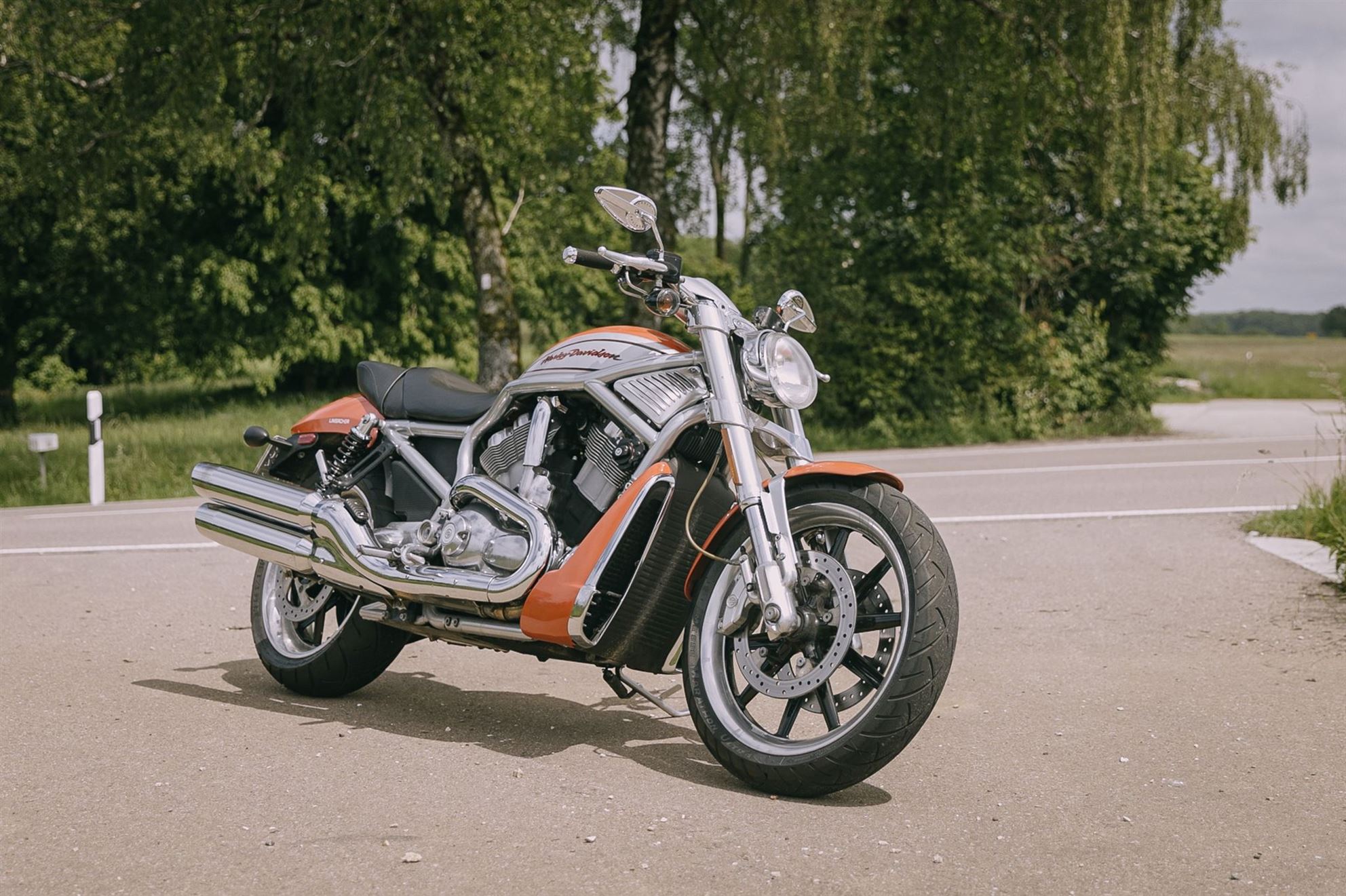
Visually, the Street Rod deviates the least from Harley traditions, but technically and ergonomically, it is the black sheep, even among its own V-Rod models.
The V-Rod models were produced in various versions, including the Night Rod, Street Rod, and V-Rod Muscle, each with slight modifications in design and performance to cater to different riding styles. Despite their innovative technology and the attempt to bridge the gap between traditional Harley style and modern street bike design, the V-Rod was controversial among traditional Harley riders. Many found them too far removed from the brand's traditional philosophy. For example, the typically uneven idle of classic Harleys was missing, and the German perfection in engine setup was unwanted by Harley purists. At the same time, the V-Rod tried to appeal to a new audience interested in sporty motorcycles, which meant it had to compete with very strong, highly sporty rivals from Japan and Europe. This is where our test bike, the Street Rod, comes into play. It was developed as the sportiest of the V-Rods, with a steeper steering head angle, shorter wheelbase, ten-spoke cast aluminum wheels, a 43-mm SHOWA upside-down fork instead of a conventional telescopic fork at the front, a 300-mm Brembo dual disc brake, higher rear frame, pegs, more lean angle, and a flatter handlebar. Together, this resulted in a significantly sportier riding position. These might also be the reasons for its unpopularity, as no other model strayed so far from traditional Harley values, and indeed, it sold the worst of all the V-Rods.
Production of the V-Rod models was discontinued in 2017 after a 16-year run that shaped Harley-Davidson in many ways. While the V-Rod never achieved the sales figures of the classic Harley models, it left a lasting impression as an innovative and bold experiment. It showed that Harley-Davidson was willing to explore new paths and adapt to changing market demands. Even today, the V-Rod is still considered by many to be one of the most extraordinary models in Harley-Davidson's history.
The test bike: Used Harley-Davidson V-Rod VRSCR Street Rod EZ: 2005 from Limbächer
The Harley-Davidson V-Rod Street Rod we picked up from Limbächer was first registered in 2005, had already clocked 17,705 km at the start of our test, and belongs to the first generation of Street Rods that saw the light of day in 2005. The 1,131 cc 60° V2 Revolution engine delivers 120 hp at 8,250 rpm and 108 Nm at 7,000 rpm in the Street Rod. This should be enough to accelerate the fully fueled 292 kg sport cruiser to 217 km/h and should also be sufficient to provide us with plenty of riding pleasure on the twisty roads of the Swabian Alb. Provided, of course, that its unpopularity does not continue with us. But now, let's hear about the riding impressions. All technocrats can find the detailed technical data sheet below.
Harley-Davidson V-Rod Street Rod VRSCR 2006 - Key Facts
Engine and Drive Train
| Engine power | 120 HP |
|---|---|
| Displacement | 1131 ccm |
Dimensions and Weights
| Wheelbase | 1700 mm |
|---|---|
| Seat Height | 762 mm |
| Dry Weight | 280 kg |
| Fuel Tank Capacity | 18.9 l |
| Top Speed | 220 km/h |
| License compliancy | A |
Harley-Davidson V-Rod Street Rod in Urban Traffic - Ergonomics & Co.
The Harley-Davidson V-Rod Street Rod gives the impression of a classic cruiser at first glance, but as soon as you sit on it, it becomes clear that it is unique. With a seat height of 803 mm, it is not too high, so even those with shorter legs should be able to reach the ground, but the difference from a typical cruiser quickly becomes noticeable. The feet need to be lifted onto the high-positioned pegs. As soon as you stretch your arms to the handlebars, the upper body takes on an unexpected, forward-leaning position. This results in an overall more sporty, forward-oriented posture that does not correspond to the classic cruiser style. Nevertheless, the seating position is not too extreme. With a bit of core tension, there is hardly any pressure on the hands, and even longer rides are manageable. The ergonomics of the Street Rod are deliberately sporty, but due to the relatively manageable dimensions for a cruiser, there is no heavy handling when maneuvering or performing tight maneuvers in urban areas.
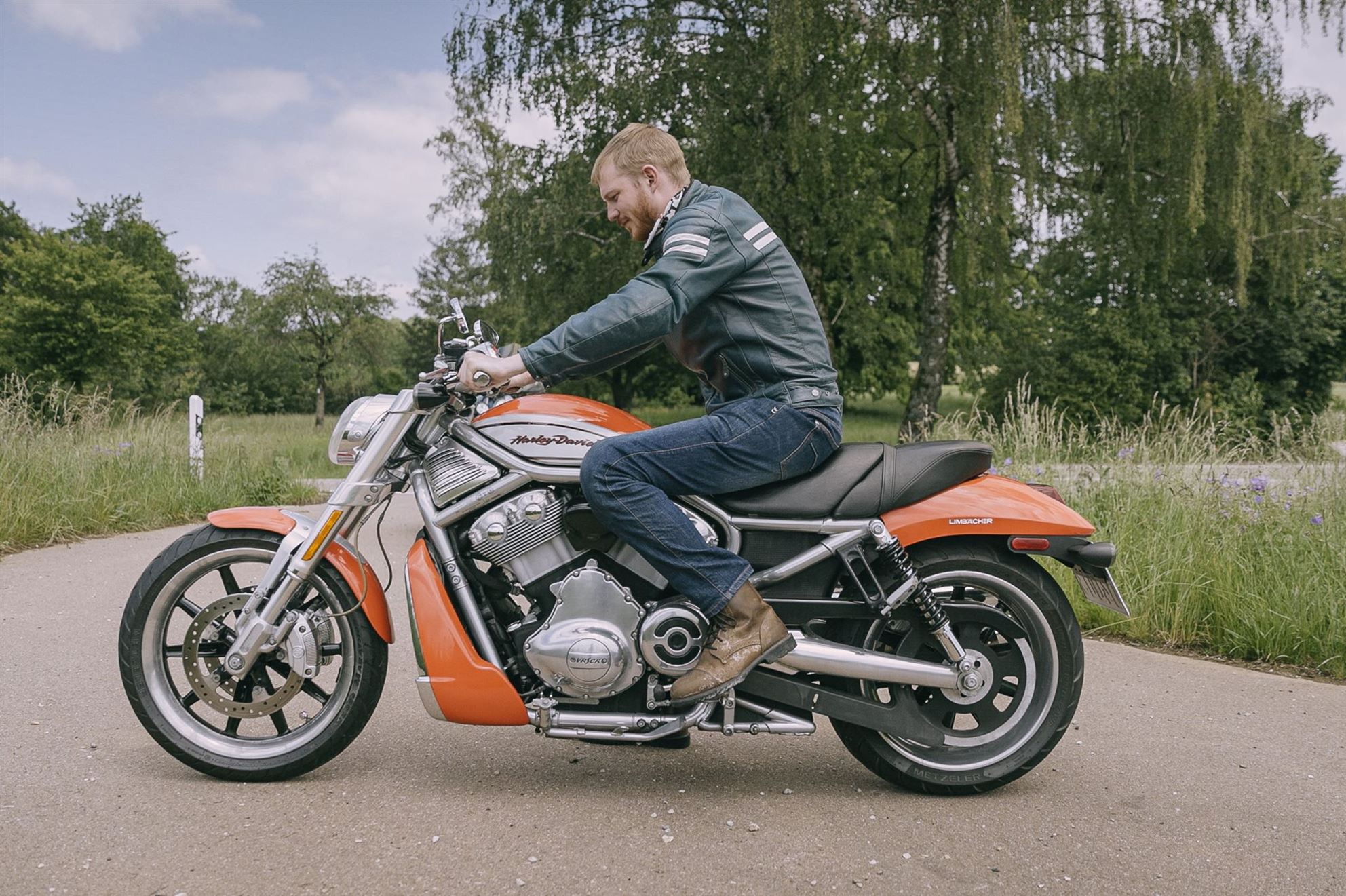
Even after a second or third glance, one might still mistake the Street Rod for a classic cruiser. But the moment you first sit in its saddle, this impression quickly dissipates.
One challenge in city traffic, especially in stop-and-go situations, is the very stiff clutch. Rarely have I encountered a clutch that requires so much hand strength to operate. After a short time, you notice how exhausting it becomes to fully engage the clutch. However, this is where a major advantage of the Harley-Davidson V-Rod Street Rod comes into play: the excellently working gearbox. It not only allows for smooth upshifts without the clutch, but downshifting is also effortless. I quickly came to appreciate this feature during my ride, as after about two hours of heavy clutch use, my left hand was pretty worn out. Well-trained athletes and muscle-bound individuals will naturally have much fewer problems here than I, a soft journalist.
Harley-Davidson V-Rod Street Rod on the country road and highway
After leaving the densely populated area of Stuttgart behind, we face a longer stretch of highway to reach the Swabian Jura with its twisty roads. On the highway and the wider federal roads, the impressive smoothness of the Revolution engine of the Harley-Davidson V-Rod Street Rod becomes apparent. The vibrations are pleasant, present enough to offer an authentic V-twin experience, but significantly less pronounced than with the classic air-cooled Harley engines. This unusual smoothness harmonizes with the mostly comfortable chassis, which still provides enough stability suitable for the sporty layout of the Street Rod. On uneven roads, larger transverse grooves and bumps are quite noticeable, but apart from that, the suspension elements offer a balanced mix of stability and comfort. The forward-leaning ergonomics proved advantageous at higher speeds, as the air pressure relieves the upper body and conveys an almost sporty riding feel, similar to a sport motorcycle where you can lean on the air cushion.
'More awesome, old bikes in the used test'
Sporty Performance of the Harley-Davidson V-Rod Street Rod
When we finally reach the Swabian Jura, the V-Rod Street Rod once again showcases its strengths. Particularly impressive is its stability combined with the high maximum lean angle of 40° as claimed by Harley. This allows the bike to be pushed through tight corners at speeds that are rarely achievable with any other Harley-Davidson. The relatively short wheelbase of 1700 mm and narrow tire dimensions (120/70-19 front and 180/55-18 rear) make the Street Rod surprisingly agile, allowing it to be leaned into curves with minimal input from the handlebars and body. The bike transitions into lean smoothly and holds its line cleanly. The brakes, equipped with Brembo components, perform solidly in sporty use. While they don't reach the peak performance of modern brakes on current sport motorcycles, they are adequately sized for the nearly 300-kilogram bike. The sporty ergonomics support the rider in the twisties, allowing for a more forward-leaning position, which provides a good feel for the front wheel despite the rather long fork. The feedback from the road is impressive and significantly contributes to the Street Rod's suitability for spirited riding.
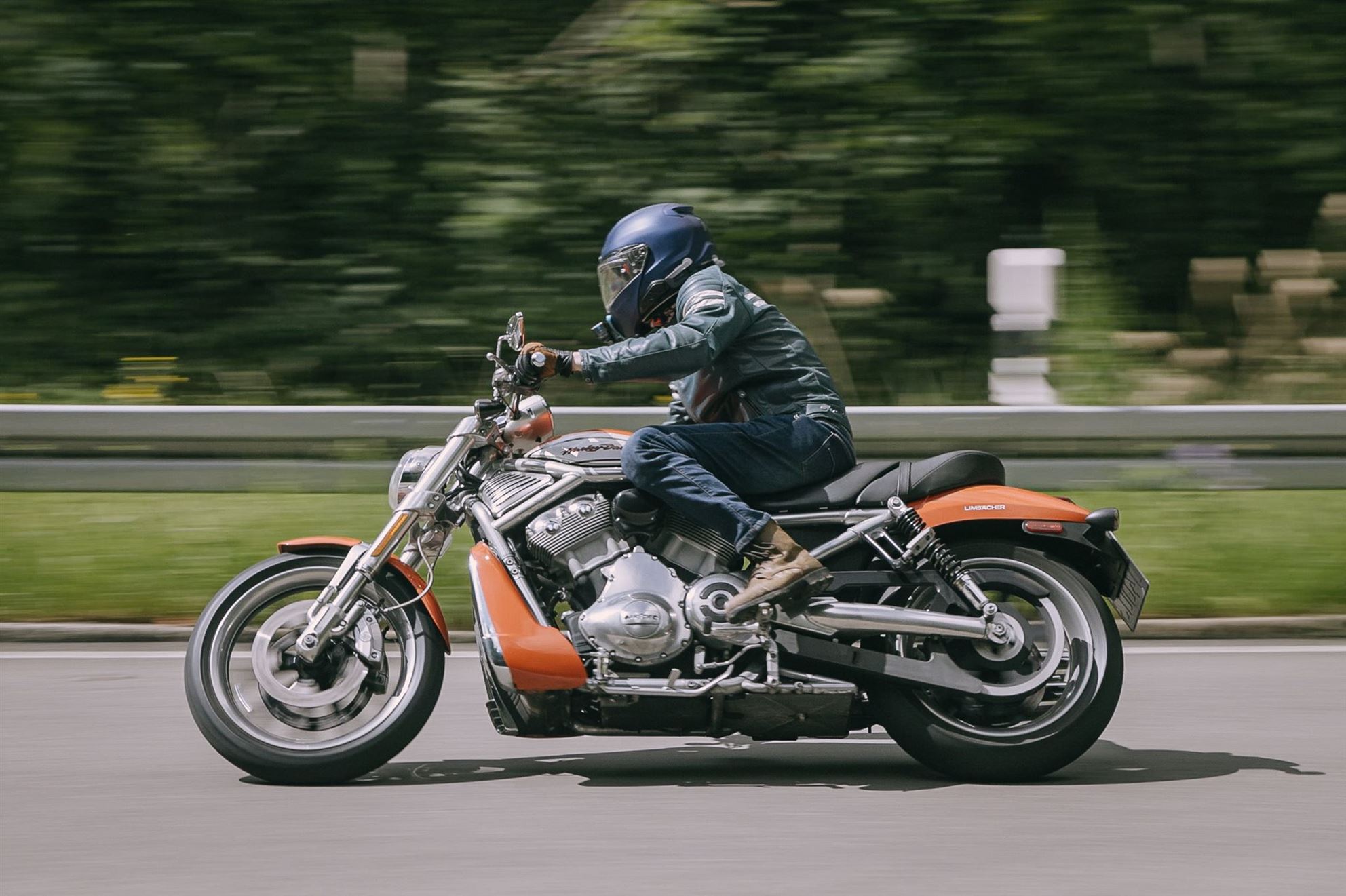
As fast and leaned over as the Street Rod, hardly any other Harley can rip through the twisties.
Unfortunately, this sporty riding experience is marred by one point: the engine. Or more precisely: the gearing. The Revolution engine itself responds well to the throttle, and the sound is a true delight – a deep, popping V2 sound that even pleasantly pops and crackles when you let off the throttle. With 120 hp and a robust torque of 108 Nm, the engine seems to offer quite sporty performance on paper. However, in practice, it becomes apparent that the Street Rod only gains momentum slowly due to its long gearing. With only five gears, the gearing is designed to keep higher cruising speeds comfortable, but this leads to sluggish acceleration in the lower rpm range. Despite the solid performance data, the bike feels less lively during acceleration than one would expect from such a sporty model. The chassis, maximum lean angle, and ergonomics allow for much more sportiness than the engine ultimately delivers – a disappointing aspect that somewhat diminishes the otherwise very successful riding characteristics. Aside from that, even in 2024, there is really not much to complain about with the Harley-Davidson V-Rod Street Rod. Small weaknesses or quirks, such as the quirky alarm system combined with the old keyless system and the sometimes subpar quality of some components, hardly manage to tarnish the otherwise very positive overall impression of the V-Rod Street Rod.
Known Issues of the Harley-Davidson V-Rod VRSCR Street Rod
Before purchasing a used motorcycle, one should familiarize themselves with the known teething problems, weaknesses, and potential technical defects. To the delight of all V-Rod enthusiasts, there isn't much to report here. The technology installed by Harley and Porsche is considered very robust, which is likely due to the rigorous testing procedures of the Porsche engineers. Harley-Davidson and Porsche founded a joint venture for engine construction, in which Porsche received a 49 percent stake. The development of the Revolution engine was characterized by extreme durability testing requirements. In the so-called Düsseldorf Test, the German autobahns connecting the research and development center in Weissach/BW with the state capital Düsseldorf in NRW were simulated in countless test runs until a machine endured a 500-hour nonstop ride. Additionally, forums and used motorcycle tests rarely report any defects in other components. From a technical perspective, one can confidently opt for the V-Rod. Only the chrome-rich periphery demands a lot of attention, or in the absence of a caring owner, it can look quite wild after a few years.
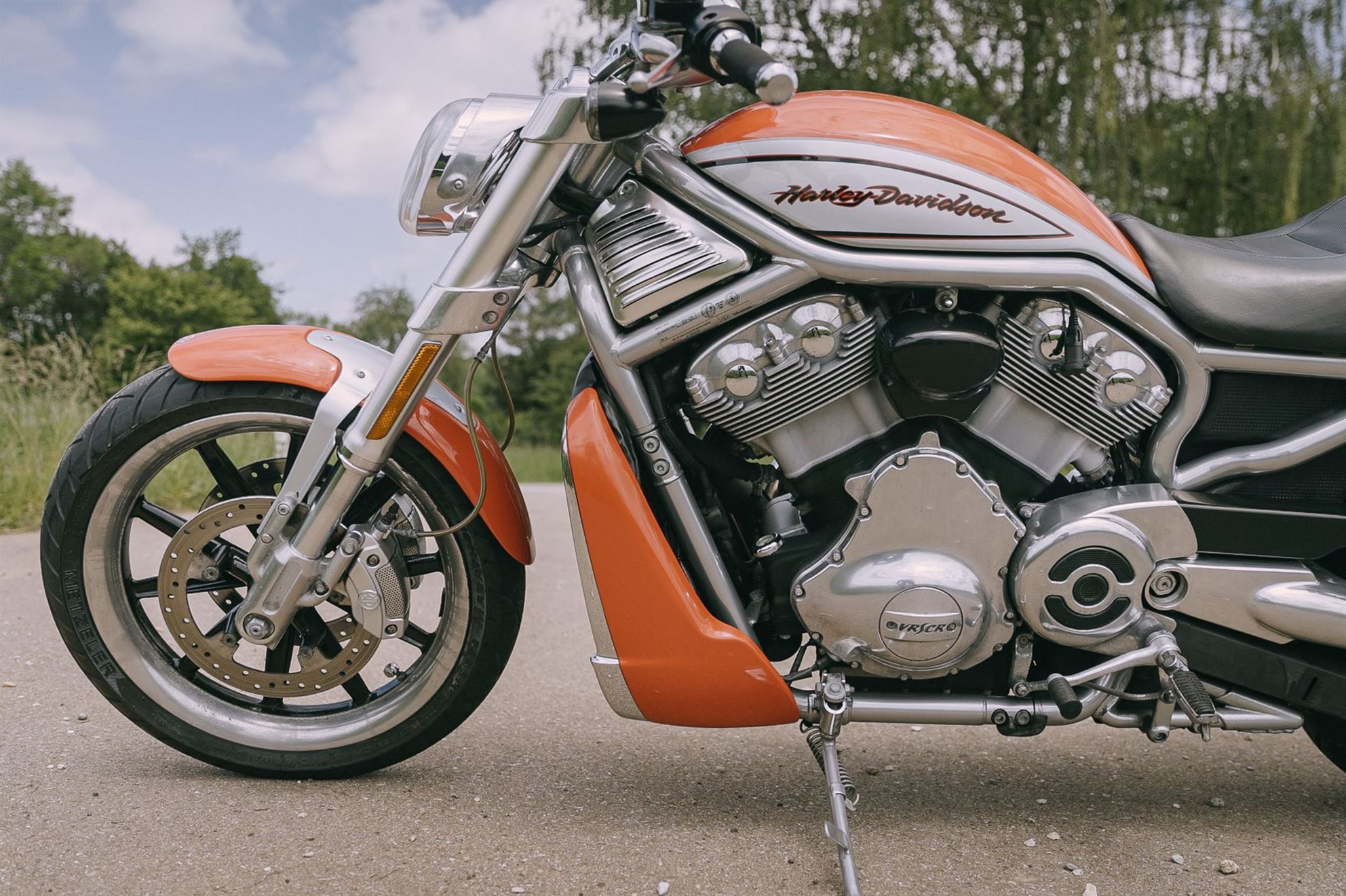
Used Street Rods need loving owners who will cherish and maintain their elaborate exterior.
Harley-Davidson V-Rod Street Rod VRSCR on the used bike market
That the Street Rod was the least popular V-Rod is not just a saying, but the sales figures also support this. For example, it sold only 436 units in Germany - during its entire lifespan! Accordingly, Street Rods are also rare on the used market today. This makes calculating a meaningful average price difficult. My research on the 1000PS marketplace and other major bike exchanges revealed that one has to shell out between €9,000 and €10,500 for a Harley-Davidson V-Rod Street Rod in Germany, and between €13,000 and just under €20,000 in Austria. Despite its general unpopularity, a small fan base has formed around the extraordinary Street Rod over the years, which is why it holds its price quite steadily.
- How much does a Harley-Davidson V-Rod Street Rod VRSCR cost?
- Here you will find an overview of the price level of new and used motorbikes!
&width=60&height=60&bgcolor=rgba_39_42_44_0&mode=crop)
Harley-Davidson V-Rod Street Rod VRSCR 2005 - Experiences and Expert Review
Gregor
The Harley-Davidson V-Rod Street Rod may be a very special Harley-Davidson, straying far from typical Harley features and sitting between the cruiser and sport motorcycle worlds, which ultimately explains its low popularity. However, even though it is neither fish nor fowl, the Street Rod has a lot to offer. A solid chassis, willing cornering behavior, good brakes, a great-sounding engine, and high maximum lean angle. Those who want to carve up some twisties quickly while not missing a certain American flair and V-twin charm should take a closer look at the Street Rod. The combination of a sporty chassis, active riding position, and powerful V-twin certainly has the potential to make the right type of rider happy.
Harley-Davidson V-Rod VRSCR Street Rod Used Bike Review & Test Images
Source: 1000PS












































